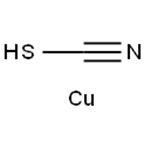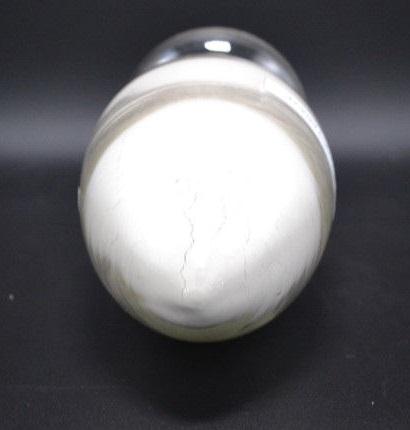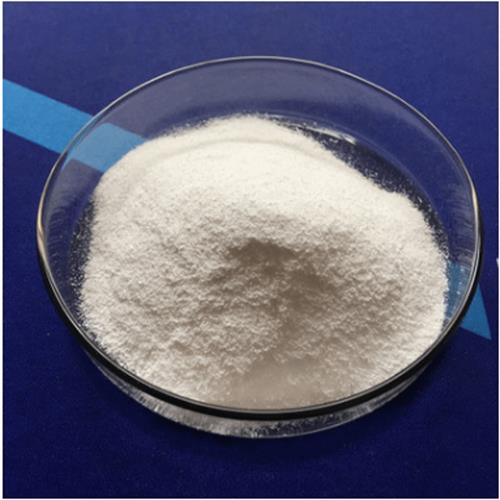Cuprous thiocyanate:preparation and application study
Introduction
Cuprous thiocyanate (CuSCN;Figure 1) is a compound which has solubility characteristics in water rather similar to those of barium sulphate. In neutral or mildly alkaline conditions the solubility is about 0.5mg% (BaSO4 0.25mg%) and in 0.1 N HCI about 3mg% (BaSO4 1mg%). Cuprous thiocyanate is, however, readily decomposed by 50% nitric acid at room temperature, or by 10% nitric acid at the boiling point.[1] Copper thiocyanate is an inorganic p-type semiconductor with the properties of high optical transparency, a wide bandgap (>3.4eV), and good thermal stability, which makes cuprous thiocyanate an ideal hole transport layer (HTL) for applications such as perovskite solar cells, organic photovoltaic devices, and organic light-emitting diodes. The deposition of CuSCN thin films mainly includes electrochemical deposition, spray-coating,spin-coating, drop-casting, and ink-jet printing.[2]

Preparation of cuprous thiocyanate
Copper sulphate (CuSO4·5H2O AR), 200g, is dissolved in about 3 litres of water with a few millilitres of concentrated HCI and brought to the boiling point. About 50 ml of saturated sulphurous acid (prepared from Na2SO3·7H2O AR and HCI) is added and mixed and then 10% KSCN AR is added slowly with stirring. Further portions of sulphurous acid are added from time to time to maintain reducing conditions. The KSCN is added until cuprous thiocyanate is no longer precipitated. The precipitate should be white and the supernatant colourless and smelling of sulphur dioxide. The cuprous thiocyanate is then filtered is suitable) and washed well with distilled water until the filtrate is free from SO4 (BaCl2 test). The pure cuprous thiocyanate is then dried in anoven at 120°C, powdered in a mortar, and weighed out into gelatin capsules.[1]
Application research of cuprous thiocyanate
Cuprous Thiocyanate as a Hole Transporting Layer
Carbon-based perovskite solar cells without a hole transport layer (HTL) are considered to be highly stable and of low cost. However, the deficient interface contact and inferior hole extraction capability restrict the further improvement of the device efficiency. Introducing a hole transporting layer, such as cuprous thiocyanate (CuSCN), can enhance the hole extraction ability and improve the interface contact. However, our further studies indicated that-at a certain temperature-for carbon-based solar cells, in the CuSCN layer, the diffusion of SCN - into the perovskite film would produce more interfacial defects and aggravate nonradiative recombination, thus hindering the carrier transport. They further disclosed the reasons for performance attenuation during the thermal treatment of carbon electrodes, proposed a vacuum-assisted drying process for carbon electrodes to suppress the destructive effect, and finally, achieved an enhanced efficiency for perovskite solar cells with a CuSCN inorganic HTL and screen-printable carbon electrode. Also, the unencapsulated perovskite solar cell demonstrated over 80% efficiency retention after being stored in an ambient atmosphere (45-70% relative humidity (RH)) for over 1000h and maintained over 85% efficiency retention for 309h of 1-sun irradiation under a continuous nitrogen flow under open-circuit conditions.[3]
Self-Powered P-I-N Perovskite Photodetectors
In this study, Y2O3-doped copper thiocyanate (CuSCN) with different x wt% (named CuSCN-xY, x = 0, 1, 2, and 3) films were synthesized onto ITO substrates using the spin coating method. UV-vis, SEM, AFM, EDS, and cyclic voltammetry were used to investigate the material properties of the proposed films. The conductivity and carrier mobility of the films increased with additional yttrium doping. It was found that the films with 2% Y2O3 (CuSCN-2Y) have the smallest valence band edges (5.28 eV). Meanwhile, CuSCN-2Y films demonstrated the densest surface morphology and the smallest surface roughness (22.8 nm), along with the highest conductivity value of 764 S cm-1. Then, P-I-N self-powered UV photodetectors (PDs) were fabricated using the ITO substrate/ZnO seed layer/ZnO nanorod/CsPbBr3/CuSCN-xY/Ag structure, and the characteristics of the devices were measured. In terms of response time, the rise time and fall time were reduced from 26 ms/22 ms to 9 ms/5 ms; the responsivity was increased from 243 mA/W to 534 mA/W, and the on/off ratio was increased to 2.47 × 106. The results showed that Y2O3 doping also helped improve the P-I-N photodetector's device performance, and the mechanisms were investigated. Compared with other published P-I-N self-powered photodetectors, our proposed devices show a fairly high on/off ratio, quick response times, and high responsivity and detectivity.[4]
In addtion,a method for the estimation of faecal fat excretion using cuprous thiocyanate as a continuous marker is described. Results obtained from a single stool sample are in close agreement with those from a three-day collection using this technique. The method is simpler and more accurate than collections done without a marker.[5]
References
1. Dick M. Use of cuprous thiocyanate as a short-term continuous marker for faeces. Gut. 1969;10(5):408-412. doi:10.1136/gut.10.5.408
2. Wang JH, Chen BC, Chu SY. The Fabrication and Characterization of Self-Powered P-I-N Perovskite Photodetectors Using Yttrium-Doped Cuprous Thiocyanate. Micromachines (Basel). 2025;16(6):666. Published 2025 May 31. doi:10.3390/mi16060666
3. Wang J, Gong S, Chen Z, Yang S. Vacuum-Assisted Drying Process for Screen-Printable Carbon Electrodes of Perovskite Solar Cells with Enhanced Performance Based on Cuprous Thiocyanate as a Hole Transporting Layer. ACS Appl Mater Interfaces. 2021;13(19):22684-22693. doi:10.1021/acsami.1c05495
4. Wang JH, Chen BC, Chu SY. The Fabrication and Characterization of Self-Powered P-I-N Perovskite Photodetectors Using Yttrium-Doped Cuprous Thiocyanate. Micromachines (Basel). 2025;16(6):666. Published 2025 May 31. doi:10.3390/mi16060666
5. Lee MF, Temperley JM, Dick M. Estimation of faecal fat excretion using cuprous thiocyanate as a continuous marker. Gut. 1969;10(9):754-759. doi:10.1136/gut.10.9.754
You may like
Related articles And Qustion
Lastest Price from Cuprous thiocyanate manufacturers

US $0.00/kg2025-10-09
- CAS:
- 1111-67-7
- Min. Order:
- 1kg
- Purity:
- 98%
- Supply Ability:
- Customise
US $10.00/KG2025-04-21
- CAS:
- 1111-67-7
- Min. Order:
- 1KG
- Purity:
- 99%
- Supply Ability:
- 10 mt



